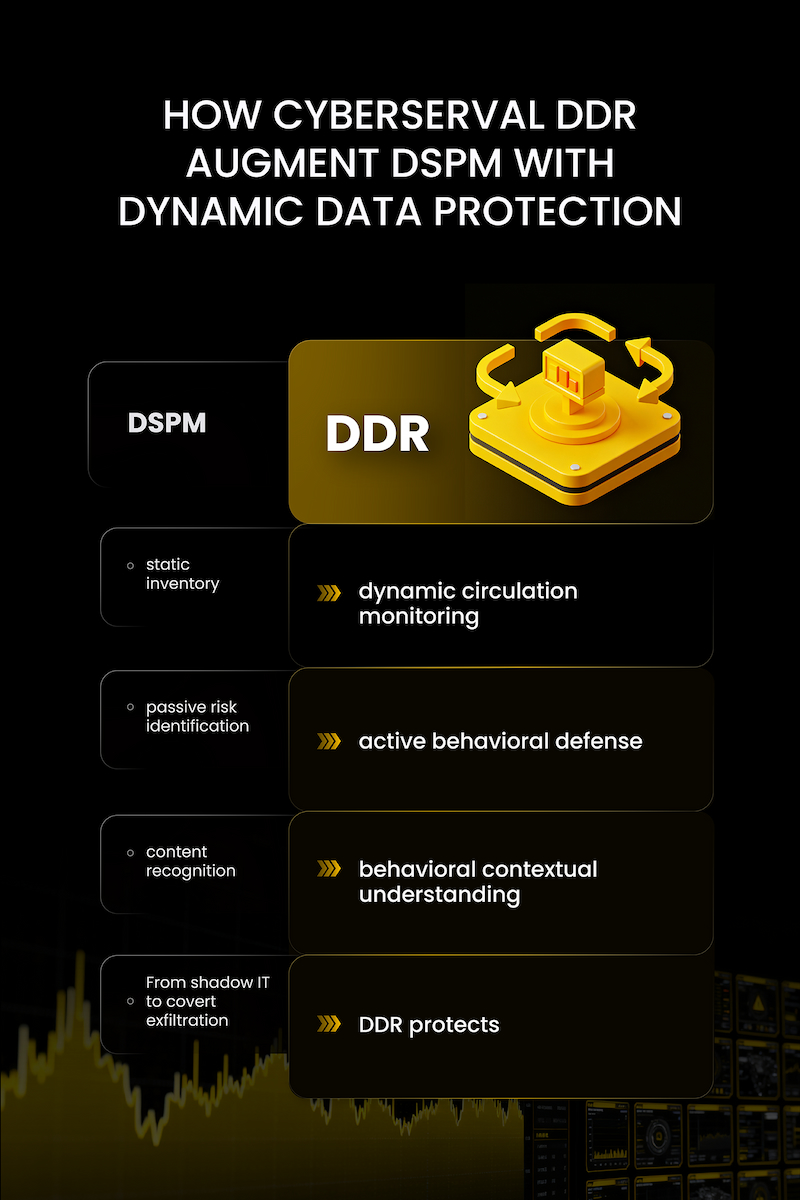CyberServal DDR: Augmenting DSPM with Dynamic Data Protection
What is Data Security Posture Management(DSPM)
Data Security Posture Management (DSPM) focuses on the identification and governance of data at rest. It discovers and classifies data assets stored by enterprises, assesses their sensitivity and risk, and analyzes permission configurations and exposures. In other words, DSPM provides a static snapshot of what data is and where it is stored, as well as a risk assessment based on the current state to establish a list of data assets and an overview of risks for enterprises.
Why Visibility Alone is Not Enough
As organizations accelerate their digital transformation, adopt multi-cloud strategies, and increasingly rely on AI and automation for agility, a reality that cannot be ignored is emerging: most security teams are losing visibility and control over distributed data. What is really missing is often a clear understanding of data risk—not only where it is stored, but also how exposed it is, what access it is, and whether it is at risk of compliance or misuse. Without these insights, it is difficult for organizations to protect against potential internal and external threats.
Key Factors to Consider and How Enterprises Should Prepare
Organizations should focus on not only visibility but also risk responsiveness, compliance adaptability, and control over future data flows. Key factors include how to manage distributed data across clouds and on-premises, how to monitor data flow and user behavior in real time, and how to dynamically adjust permissions and policies to reduce risk. Organizations need to establish a unified data security framework in advance, combining situational management with real-time defense to cope with complex and changing threat environments. CyberServal Next-Gen DLP solutions (DDR) effectively complements the static view of DSPM with its dynamic detection and response capabilities, extending data security from "identifying existing risks" to "responding to current and upcoming risks in real time."
RELATED: Why Monitoring Dynamic Data is Crucial for Modern Data Security
How CyberServal DDR Augment DSPM with Dynamic Data Protection
From static inventory to dynamic circulation monitoring
◦ Static of DSPM: DSPM is able to discover and classify data at rest, identify which sensitive data is stored where, and who can access them (permission configuration).
◦ DDR dynamics: CyberServal Next-Gen DLP (DDR) continuously monitors the movement and use of sensitive data. It tracks the data flow through the whole chain, and DDR can track and record in real time no matter how the data is used, modified, copied, and transmitted by users from a static state. This covers data in use and data in transit states, which are often difficult for DSPM to cover. Forcepoint also mentioned that its DDR is an add-on to DSPM, which enables continuous monitoring of "data in use".
From passive risk identification to active behavioral defense
◦ Passivity of DSPM: DSPM is more about identifying existing risks, such as sensitive data being stored in an insecure location or users having excessive privileges. It tells you which data is at risk.
◦ DDR Proactiveness: CyberServal Next-Gen DLP (DDR) proactively detects and responds to suspicious user behavior. With UEBA, it analyzes user and entity activity to identify anomalous data actions (e.g., large-scale downloads, non-work-related accesses, pre-employment data transfers). It doesn't just indicate the presence of risks, but intervenes in real time (alert, block, approve, or dynamically adjust permissions) when risk behavior occurs.

From content recognition to behavioral contextual understanding
◦ Content focus of DSPM: DSPM focuses on classifying data at rest through content recognition such as keywords, regular, fingerprints.
◦ Behavioral context focus for DDR: CyberServal Next-Gen DLP (DDR) combines content and context to track the full lifecycle of data. Its AI insights engine not only understands the data content itself but also dynamically adapts to the context to identify sensitive information. More importantly, it provides insights into the flow of data under specific applications, protocols, and user behaviors through kernel-driven monitoring and application layer hooks, filling in the gaps in the dynamic dimension of "how data is used and flowed" in DSPM.
Deal with shadow IT and hidden channels
◦ Limitations of DSPM: DSPM can present challenges in discovering and managing shadow IT assets, especially when data enters uncontrolled internet environments or SaaS applications.
◦ DDR extensions: CyberServal Next-Gen DLP (DDR) provides browser control and monitoring of multiple covert transmission channels (e.g., command line, WinSCP, LAN transport). This allows it to identify and block sensitive data from being exfiltrated through these "atypical" or "unsanctioned" routes, extending protection against shadow IT and unknown risks.
If DSPM builds the foundational "map" of enterprise data security – telling you where and what your data assets are, then CyberServal Next-Gen DLP (DDR) maps out real-time "navigation" routes and "traffic control" systems on this map, ensuring that every movement and use of data on the map is safe and controllable, and that it can respond immediately to anomalies. Book a meeting, get a data risk assessment, and take the first step towards smarter, more secure data management.